MYOPIA CONTROL
WHAT IS MYOPIA?
What is myopia, and why should we be concerned?
Myopia is commonly known as short-sightedness or near-sightedness. It is when the distance vision becomes blurry and in most cases, the near vision is clear. Corrective glasses and contact lenses are prescribed for myopia to provide clear vision.
Myopia has become a global health risk. Its prevalence has surged in recent decades. By 2050, the World Health Organisation predicts that myopia will affect about half the world’s population. In some countries such as South East Asia, prevalence is close to 80-90%.
The health risk is due to a number of eye diseases associated with myopia that can lead to blindness. More commonly associated diseases include cataract, retinal tears and detachments, glaucoma and maculopathy.
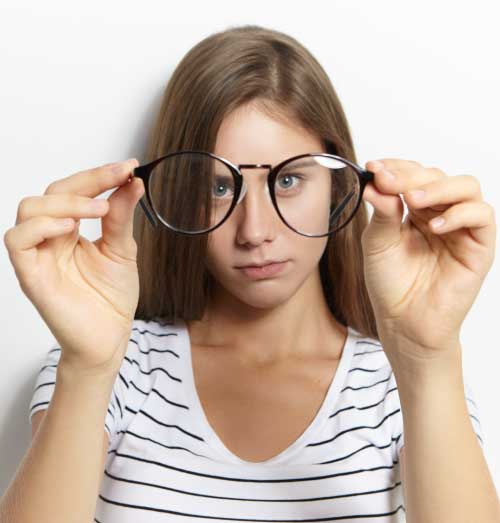
Testing for myopia
The optometrist performs a refraction test by using either a trial frame or a phoropter unit. By changing a combination of lenses and asking for your responses, your distance prescription is determined. For young children and babies, a retinoscope (a hand-held tool) is used to obtain the prescription objectively. Sometimes it may be necessary to dilate the pupils to assist in determining the final prescription.
Myopia progression and myopia forecast
There are two measurements used to monitor myopic progression particularly in children whose eyes change at a faster rate. The first is the refraction which is the prescription measured for each eye. The second is axial length which is a measurement of the length of the eye ball from the cornea to the retina. Axial length is a more sensitive and accurate way to monitor progression. To measure axial length you need a biometry unit. At our practice we have the latest myopia unit, Lenstar Myopia, from Haag-Streit Switzerland who has been producing advanced clinical tools for several decades.
The Lenstar Myopia is more than a diagnostic tool; it is also a myopia management and patient education system. It presents a growth curve chart the predicted myopia forecast of a child to adult age. It does so by taking into account the initial refraction and variables such as parental myopia, time spent on near activities, time spent on outdoor activities, ethnicity and the age of the patient. It also presents how various evidence based myopia treatments can be used to optimally reduce the amount of myopia in a child over time compared to the projected rate of progression without intervention. This unit can also be used as a predictor for the onset of myopia and the risk of retinal disease if the axial length finding is longer than expected.
The health risk is due to a number of eye diseases associated with myopia that can lead to blindness. More commonly associated diseases include cataract, retinal tears and detachments, glaucoma and maculopathy.
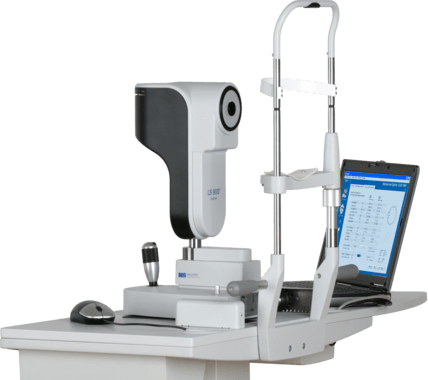
Myopia FAQ
There are a few key risk factors of myopia:
- Parents with myopia
- The higher the amount of myopia, the faster it tends to increase.
- The younger the child, the faster the myopia has shown to increase.
- East Asian ethnic children
- If there is a binocular dysfunction due to imbalance of clarity between the eyes or poor eye teaming, myopia can progress faster.
- Increased time spent at near and minimal time spent outdoors, is associated with an increase risk of myopia.
- Childrens’ eyes grow faster so their level of myopia increases at a faster rate than teenagers and young adults.
- The younger a child develops myopia, the worse their level of myopia will generally become when they are an adult, leading to higher ocular health risks.
- In most cases, myopia stops at about age 20 but some cases can continue to progress to age 25.
- Yes, adults can develop the onset of myopia due to fatigue associated with concentrated near work for long periods. However they tend to stabilize at a prescription that relates to the tasks they are mostly performing.
- Adults who have had laser surgery to correct their myopia can also become short-sighted again due to this same reason.
- In general, children should be routinely examined every two years from 6months of age by an optometrist and then yearly when they commence school. About 1 in 5 children have eye problems, as a result of poor vision, poor eye teaming and ocular diseases.
- Sometimes it is not obvious that a child is short-sighted. Children may not complain of blurry vision, headaches, or tired eyes. Symptoms may be mild, child may be too young to know what is ‘normal’ vision and some may avoid telling their parents as they don’t want to wear glasses.
- To assess the risk of your child becoming myopic, please complete this survey.
- Follow the 20/20/2 rule. It means for every 20minutes of near task (such as reading or screen time), look into the distance (furthest place in the room or outside through a window) for 20 seconds, and spend at least two hours outdoors.
- Ensure the child wears the most appropriate correction for myopia control. Wearing single vision glasses or contact lenses to clear the distance vision will NOT slow down myopia progression, as these modalities do not correct the underlying cause. A thorough eye examination by an optometrist can determine the best correction for your child.
- Controlling myopia is about quality of life and reducing risk of eye diseases that can lead to blindness. With a lower degree of myopia, you are more functional without your correction, you may be able to drive without your correction, and you have a higher chance to be able to undergo laser correction when you’re older and the eyes are more stable.
- We are very fortunate to have a range of treatments for treating myopia at all ages. Over the past two decades, lots of research has been dedicated to finding ways on how we can control myopia progression.
- The best treatment option will be based on a number of factors such as the age of the patient and other risk factors, the environment, available support at home, financials, daily activities and lifestyle needs.
- Currently there is no method that will completely STOP myopia from progressing. Research has shown that we can SLOW down myopia by about 50% or more if we use the following options – ortho keratology contact lenses, myopia control contact lenses, myopia control spectacles, low concentration atropine eyedrops and vision therapy.
- It is very important to understand that visual hygiene must be followed. If the patient continues to have too much time on near work, little time spent outdoors, or is not wearing or using the treatment as prescribed, their myopia can progress faster than anticipated. Also bear in mind that studies are generally undertaken on 8-14year olds and with lower levels of myopia. So children outside this range may not get the expected ‘average’ outcome.
Ortho-Keratology
Orthokeratology (or Ortho-K for short), has been around for many years. It was first FDA approved in the USA in 1992, to be worn safely as an overnight contact lens. It is a rigid contact lens designed to gently reshape the eye to correct its myopia whilst the patient is asleep. The lenses are comfortable to wear and are removed on waking providing you with functional vision during the day, free from glasses or day-time contact lenses. It is particularly advantageous for those engaged in sports, particularly contact sports or water sports.
Ortho-K is fully reversible; its effect on vision correction is temporary. When overnight lens wear is stopped, the patient returns to their previous vision correction modality. Lenses need to be worn every night, except in cases where the myopia is low, the patient may only need to wear them on alternate nights. In the majority of cases, patients can see as clearly as their glasses. Sometimes they may not due to many factors such as an unusual shaped eye, unusual prescription, dry eyes or insufficient sleep hours.
Despite this, the effect of Ortho K to control myopia is about 50%. This is most important, especially in young children who progress rapidly. In some cases, there is even a halt in myopia progression, particularly seen in teenagers and young adults.

The fitting procedure for Ortho-K lenses is more involved and requires special training by optometrists. Just like getting braces for teeth, they require more follow-up visits. However once your program is complete in 6months, reviews are required every 6 months and a small fee for corneal topography (to accurately measure the shape of the eye) is charged. Ortho K lenses typically last 1-2years, so they need to be well-cared for.
The risk of getting an eye infection from wearing Ortho-K lenses is very low and comparable to adults who wear re-usable day-time contact lenses (fortnightly or monthly). It is about 13 per 10,000 years wear. The risk of soft overnight contact lenses that are prescribed to adults (and rarely in children) is higher than Ortho K, at 25 per 10,000 years wear. In research studies, they found children to be safer contact lens wearers, most likely due to better compliance in caring for their contact lenses and having adult supervision at home.
Ortho-Keratology FAQ
Ortho-K lenses are corrective lenses, so when you wear them you can see clearly with them on. However as they mould the eye shape overnight, upon removal, the vision generally remain clear for the whole day, giving you freedom from glasses and contact lenses.
The cleaning and disinfection process is performed every morning upon lens removal. Both the parent and child will be guided on how to care for the lenses and take home written instructions will be provided. Remember to always take care when handling these lenses and never rush, to avoid breakages and losing the lens.
Most of the semi-custom lenses costs $600-$700. Complex cases may require fully customised lenses which can cost about $1,000 a pair. The prices vary due to the lens design, lens material and manufacturer’s warranty.
The professional fees for Ortho-K treatment plan varies from $1500 to $2400, depending on the prescription, expected difficulty of the fit and lens design required. For very usual prescriptions, costs can be higher but these are not commonly encountered. The program is for 6months and the fee covers all appointments during this period, including the first pair of lenses. It will also cover for any necessary lens changes at no extra charge.
There is no age limit for Ortho-K in children. However the child and parent both need to be comfortable with the processes involved and has considered all other alternatives. Patients as young as 6 years have been fitted successfully.
Review is recommended every six months to monitor progression and this part is bulk-billed. A corneal topographical map is required to ensure the lens is fitting well for good vision and good ocular health. There is a small fee of $55 for this scan.
The optometrist will assess the lenses at each review. Typically lenses need to be changed at 18months, sometimes earlier at 12 months or later at 2years especially for those who wear the lenses on alternate nights. Lenses do suffer from wear and tear, get warped and scratched. When warped, vision is not corrected optimally. When scratched, there is increase risk of bacterial particles attaching to the lens.
Myopia Control Soft Lenses
Research has shown that there are two centre-distance multifocal lens design soft contact lenses that work to control myopia progression by about 50%.
The CooperVision MiSight 1-Day is a dual focus lens which has a centre clear for the distance and peripheral treatment zones and became FDA approved in 2019.
The Visioneering Technologies NaturalVue Multifocal 1-Day lens is an extended depth of focus lens. Both these products have both been approved for treatment of myopia in children and adults.

MYOPIA CONTROL SOFT LENSES FAQ
For myopia management, it is recommended that the child wears them for at least 6 days of the week for about 10 hours each day. When they are not wearing these contact lenses, they should be wearing spectacles that provide myopia control.
Generally low astigmatism can be masked in these spherical lens designs. However higher amounts of astigmatism may require glasses to correct for this in order for the child to see clearly.
They are easy to fit by the optometrist so generally professional fees are considerable less than for Ortho-K. They cost about $4 a pair. On a per year basis, they are more costly than Ortho-K lenses. However, as they are 1 Day disposable lenses, they do not require cleaning and there is no risk of losing or breaking them.
Yes, there are other lens products that offer myopia control by about a third, and these may be cost less. Products include the Mark’ennovy Mylo extended depth of focus monthly soft disposables and the CooperVision Bioinfinity centre-distance multifocal monthly disposables. Keep in mind that 1 Day lenses generally are more comfortable to wear and have a lower risk of infection.
Soft lenses worn on the eyes are more secure compared to glasses and hence will exert a more consistent myopia control effect. Glasses can fall off the face or even break when the child is engaged in active activities. Children generally have a better self esteem and confidence, and are more socially accepted if wearing contact lenses. Their ability in sports is improved due to better peripheral vision and more stable vision when wearing contact lenses.
Myopia Control Spectacles
Currently the most effective spectacle lenses for myopia control in Australia is the MiyoSmart lenses. It is based on a unique design which tries to imitate how light should fall on the retinae for clear vision. A two year study showed it slowed down myopia progression by 60% in children 8-13years old.
New lenses being designed for myopia control include the Stellest lenses and SightGlass Vision.

MYOPIA CONTROL SPECTACLES FAQ
Retail price for these specialized lenses are about $600 a pair. It comes with a six months warranty which covers for a free set of lenses if the prescription has increased by -0.50D or more during this period.
Yes, there are other lenses on the market which can offer up to about a third in reducing myopia progression. These include MyoVision, Eyezen, Sync, bifocals, progressive addition lenses.
Myopia progression and myopia forecast
There are two measurements used to monitor myopic progression particularly in children whose eyes change at a faster rate. The first is the refraction which is the prescription measured for each eye but this is often variable especially in young children. The second is axial length which is a measurement of the length of the eye ball from the cornea to the retina. Measuring axial eye length is up to ten times more sensitive, hence is a more accurate way to monitor progression.
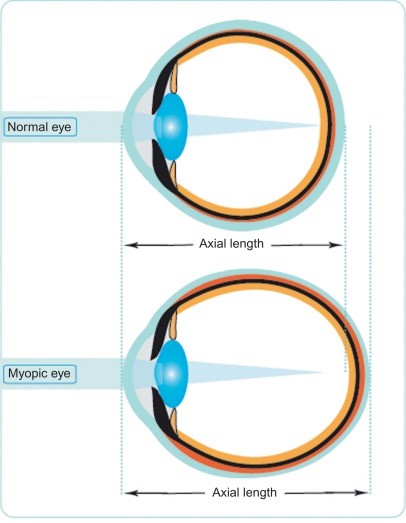
Lenstar laser interometric biometry
To measure axial length you need a biometry unit. This scan is not part of mainstream optometry. At our practice we are passionate about managing myopia so was one of the first to invest in the Lenstar Myopia, from Haag-Streit Switzerland, who has been producing advanced clinical tools for several decades. It is a quick, reliable and easy to use machine, even on young children.
The Lenstar Myopia is more than a diagnostic tool; it is also a myopia management and patient education system. It presents a growth curve chart, the predicted myopia forecast of a child to adult age. It does so by taking into account the initial refraction and variables such as parental myopia, time spent on near activities, time spent on outdoor activities, ethnicity and the age of the patient. It also presents how various evidence based myopia treatments can be used to optimally reduce the amount of myopia in a child over time compared to the projected rate of progression without intervention. This unit can also be used as a predictor for the onset of myopia and the risk of retinal disease if the axial length finding is longer than expected. The health risk is due to a number of eye diseases associated with myopia that can lead to blindness. More commonly associated diseases include cataract, retinal tears and detachments, glaucoma and maculopathy.

Measuring axial length has become a clinical necessity at our practice. It allows us to intervene and start treatment early when needed, in order to protect long-term eye health and vision. I am frequently asked “If I do the right things, can the eyeball shrink?” Unfortunately, no, just like our height, we continue to grow taller with age and good health. Eyeballs will naturally grow but the rate slows down with age. However, genetics and environmental factors can increase this rate to cause stretching and weakening of tissues at the back of the eye, leading to vision impairment in later life.
Axial length measurements need to be repeated regularly, depending on the various risk factors and rate of progression. Children who have both parents myopic, are of East Asian ethnicity, developed myopia at a young age, have a high refractive error, spend little time outdoors and spend a lot of time on near activities are at the highest risk. The International of Myopia Institute (IMI) guidelines recommend that scans be repeated every six months, however, in cases where there is fast progression, to monitor these cases every three months. For older children and adults who are stable, scans can be done annually. As a further note, we sometimes do one-time measurements on adults who are myopic regardless of their prescription. This allows us to assess their risk of potential eye diseases at that time.
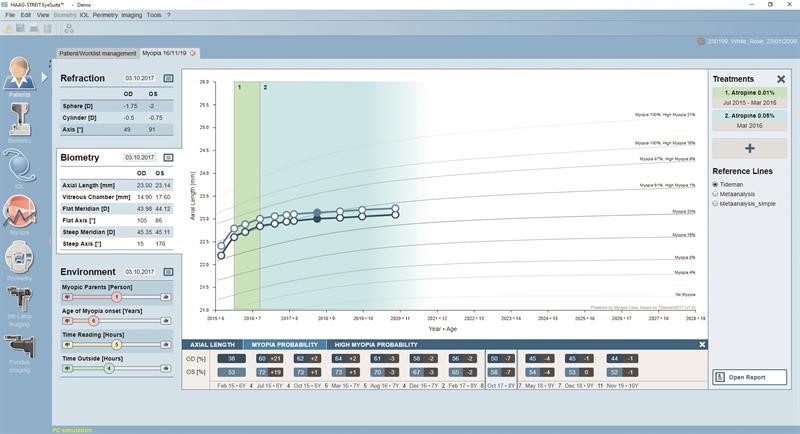
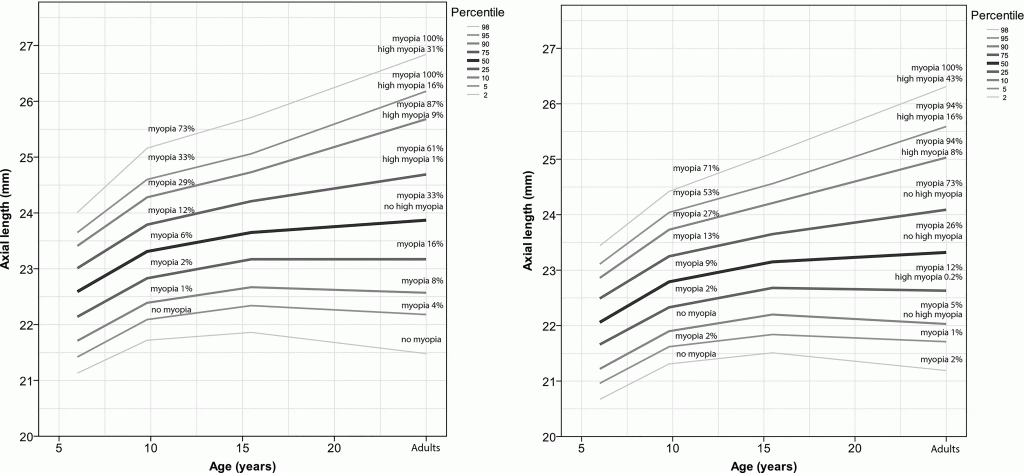
Low Concentration Atropine Eyedrops
Atropine eyedrops are effective for myopia control and can be used safely, in combination with spectacles or contact lens options. They are easy for parents to instill in their child. The recent research study, the Low-Concentration Atropine for Myopia Progression (LAMP) demonstrated that 0.05% concentration was able to reduce myopia progression by 50%.
Children at most-risk such as a young age, myopic parents, Asian ethnicity and are myopic, are prescribed these drops. They are instilled once daily, usually at night time.
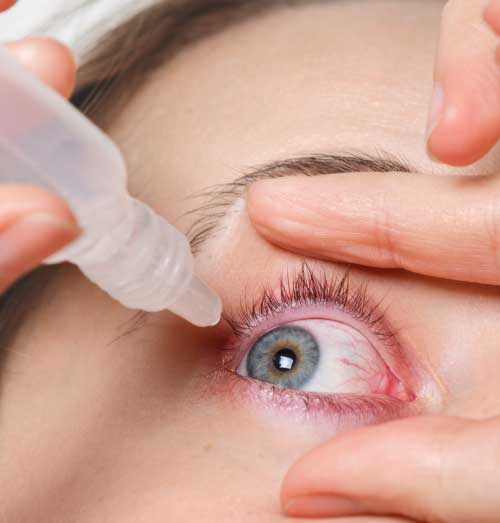
LOW CONCENTRATION ATROPINE EYEDROPS FAQ
Studies looking at children using low-dose atropine eyedrops over a five year period found them safe to use. Generally once the child is showing signs of stability in their prescription, the drops are no longer prescribed. Concentrations of 0.025% and 0.05% are well-tolerated. The drops can have a mild dilating effect causing slight increase in glare sensitivity, and also mild blur at near. The systemic side effects of these drops are rare.
These eyedrops are made to order from a compound pharmacy, and can cost up to $45 per bottle per month’s supply.
The research study Atropine for the Treatment of Myopia 2 (ATOM2) in 2015 showed that the 0.01% had the least side effects, least rebound effect and exerted good myopia control. However the latest LAMP study in 2018 indicated that 0.01% actually had minimal effect on reducing myopia progression.
The higher concentration atropine eyedrops such as 0.5% and 1% have been shown to be very effective. However the ocular side effects of photophobia and near blur means the child would have to be prescribed bifocal/multifocal type photochromatic glasses to combat these effects. Furthermore, the longer-term effects are unknown in these higher dosages.
Vision Therapy
In some systems, the eyes do not team well together and this can cause stress to the visual system. A personalised vision therapy program and advice on visual hygiene can help train the way the brain uses both eyes, thus reducing the risk of myopia progression. However, vision therapy takes time and typically most programs run for 12 to 24 weeks.
Vision therapy can be used in conjunction with other methods of myopia control. If a child is myopic, he will need to wear spectacles or contact lenses for clear distance vision.

VISION THERAPY FAQ
Yes, if detected early, vision therapy can help reduce near stress that can occur due to a variety of reasons. An optometrist trained in paediatric care can conduct a full assessment to determine the underlying cause and provide a customised vision therapy program.
Blocks of 6 weekly in-office sessions cost $500 per block and ‘homework’ tasks are given to the child to perform each day. These tasks generally take 10-15 minutes to complete. In most cases, two blocks are required. In more complex cases more sessions are required. The optometrist will be able to discuss the expected time frame after a thorough examination.
